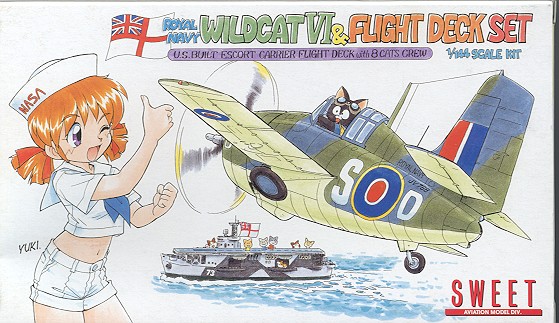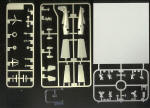
| KIT: | Sweet 1/144 Wildcat VI and flight deck |
| KIT #: | 11 |
| PRICE: | $12.00 at the Atlanta Nationals, MSRP higher |
| DECALS: | Four options |
| REVIEWER: | Scott Van Aken |
| NOTES: |

| HISTORY |
The US Navy's first really combat capable monoplane fighter was the F4F Wildcat. The Brewster Buffalo that preceded it was easily cut to pieces by the Japanese in its few combat sorties early in the war. What the Wildcat had that the Buffalo didn't was a very strong construction, good armor protection and, in the -3 variant with which the Navy went to war, it had four .50 calibre machine guns with a goodly amount of ammunition.
Pilots learned not to dog-fight with the Japanese, but to do hit and run maneuvers, using the strength and diving speed of the Wildcat against the lightly armored Zeros. Many pilots gained a great deal of success with this and eventually gave a good showing for their efforts. The aircraft was modified with folding wings and two more guns which the pilot's didn't like. The wing fold mechanism meant more planes could be carried on the ship, but that and the guns added weight. What's more, the addition gun meant less ammo per gun so they couldn't shoot as long at the enemy.
Eventually, the Wildcat was pulled from the fleet carriers and replaced by the Hellcat, but during that time, a more powerfully engined Wildcat was developed as the XF4F-6 that was built in large numbers as the FM-2 by General Motors. It went back to four wing guns and was deployed on smaller escort carriers that were used mostly for convoy and fleet protection. The British also used a lot of FM-2s under the designation Wildcat VI while operating in the Atlantic and Mediterranean, where they were much appreciated by their pilots for their sturdiness.
| THE KIT |
 Back
about a year ago, I built the US FM-2 version
of this kit and as far as the actual Wildcat goes, nothing is different.
The kit is still very nicely molded to a modern standard and offers no real
options other than drop tanks. The holes are already drilled for them so if
you don't want them you'll have to fill in the receptacles. The landing
gear is probably the weakest part of the kit and I recall breaking mine
during construction so care needs to be taken with these parts.
Back
about a year ago, I built the US FM-2 version
of this kit and as far as the actual Wildcat goes, nothing is different.
The kit is still very nicely molded to a modern standard and offers no real
options other than drop tanks. The holes are already drilled for them so if
you don't want them you'll have to fill in the receptacles. The landing
gear is probably the weakest part of the kit and I recall breaking mine
during construction so care needs to be taken with these parts.
What is the major addition to this
kit is the flight deck section. It is a pretty much standard USN-type of
deck with tie down sections running across it. The kit also includes a full
feline deck crew to go along with things, though I'm not sure they are
totally accurate for the time period......
Instructions are identical on one side to the earlier US FM-2 kit. They are totally in Japanese so any advice given in there was completely missed by me. The other side shows the four decal and painting options. Two of them are for the Extra Dark Sea Grey/Dark Slate Grey over Sky scheme and the overall Gloss Sea Blue is used for the other two. Most of us will undoubtedly go for the overall Gloss Sea Blue scheme as it will be a lot easier to paint! Decals are well printed and since those on the A6M done a while back were not too bad, these should be of equal quality. They are well printed and seem to be fully in register.The side of the box has painting instructions for the feline deck crew (offering USN and RN uniform options), and while no similar instructions are provided for the deck, I'd think that a Navy Deck Blue would be appropriate.
| CONCLUSIONS |
Yet another cool kit from Sweet. The addition of the flight deck section is a good one and there are clips provided should you wish to buy several other similar kits and hook them together. It is a good environment on which to display the Wildcats that you may have purchased in the past. Thanks to the logical construction, most of us will have this aircraft done in a very short time and it will also provide an excellent little model.
Kit courtesy of me and the neat prices of Hobby Link Japan at the Nationals.
September 2005
If you would like your product reviewed fairly and quickly by a site that has around 300,000 visitors a month, please contact me or see other details in the Note to Contributors.